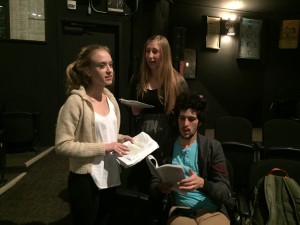Harper Joy Theatre’s production of The Seagull directed by guest artist Paul Budraitis opens Thursday, May 5 at 8 pm. Tickets are available now.
Thirteen actors stand in a circle. They shift their weight back, and then run straight towards each other. All slow down to a snails pace as they navigate how to pass through the center of the circle at the same time, before speeding up to a run and completing the exercise with a jump in unison. This is just one of many exercises taught by Paul Budraitis, who has been teaching the cast of Anton Chekhov’s The Seagull principles of Meyerhold’s Biomechanics.
As the stage manager for The Seagull, I have had the opportunity to watch and join in with the actors as they learn more about biomechanics and develop a physical training in order to build habits of natural, efficient movement on stage. It was created by the Russian director Vsevolod Meyerhold, who had trained under Stanislavsky before breaking away to start his own theatre. In fact, Meyerhold has a special link to The Seagull; He played the role of Konstantin directed by Stanislavsky at the Moscow Art Theatre in 1898.

One of the principles of biomechanics is controlling movement from the center. It is similar to dance and other forms of physical training that places emphasis on the center and an economy of movement. Movements are broken down into three parts: otkas, which translates to refusal, posyl, the sending, and tochka, the period at the end of the phrase. The control of the movement comes from tormos, which literally means brake. Paul encourages us to think of tormos as a gas and break pedal in conversation with each other. It is tormos that allows a pack of actors to pass through the center of a circle and come out the other side at the same time.
Lauren Rekhelman, a junior theatre major playing the role of Paulina, loves the biomechanics training. “I think it’s a really good way to get in touch with your body before a performance. It helps to remind yourself that your body is your instrument and you can act with your whole body. And it makes your choices more grounded and natural.”
Emily, also a junior theatre major who plays the role of Arkadina, agrees. “It gets you out of your head. I tend to think very intellectually about the play and biomechanics training helps me approach it a different way.”
You can see everyone’s hard work pay off when the show opens next week. Get your tickets now for the 5-8th or May 19-21, graduation weekend! Call the HJT box office at 509 527-5180.
Your point of view caught my eye and was very interesting. Thanks. I have a question for you.